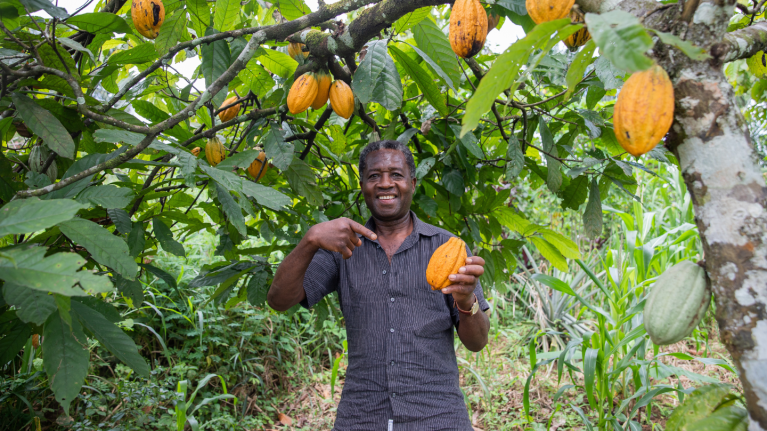
- Trends & Insights
- Nestlé In Society
Nestlé Cocoa Plan Promotes Better Farming, Better Lives, Better Cocoa
Great cocoa is important to Nestlé, as is the welfare of our small suppliers internationally.
The cocoa supply chain represents many challenging issues. The majority of cocoa farmers are small holders with low productivity and incomes, living in poor communities, with depleted soils and older, less productive trees. They often resort to using their children for tasks that could be harmful to their physical or mental development and are therefore classified as child labor. Women in the cocoa supply chain are often under-rewarded for their work, or not given a voice in their communities. In addition, customers increasingly want to know where their food comes from, making traceability more important.
Our Commitment: Nestlé Cocoa Plan with Cocoa Farmers
Nestlé buys around 414,000 tons of cocoa annually, for chocolate and confectionery as well as beverages. Our beans and processed cocoa come from major cocoa-growing countries including Côte d’Ivoire, Ghana, Brazil, Ecuador, Venezuela, Mexico, and Indonesia.
Introduced in 2009, the Nestlé Cocoa Plan is a global initiative to help improve the lives of cocoa farmers and the quality of their products while also assuring a sustainable cocoa supply for years to come. It operates across three key pillars:
- Better farming, addressing issues such as agricultural practices and rejuvenation of plantations;
- Better lives, which seeks to empower women and eliminate child labor; and
- Better cocoa, which covers certification and building long-term relationships in our supply chain
The Nestlé Cocoa Plan continues important work with farming communities through education, improving social conditions, building capacity, and other activities.
Our Partners
Underlying all these activities are transparency and partnerships. In 2016 we continued our work within the World Cocoa Foundation’s CocoaAction, the industry strategy for cocoa sustainability. We developed our relationship with UTZ (a branded program for sustainable farming of coffee, cocoa, tea, and hazelnuts) to extend the organization’s work from certification to field key performance indicator (KPI) collection, and began a partnership with Jacobs Foundation to add literacy training to our child labor initiative. In addition, we work with the Fairtrade Foundation, the Fair Labor Association, and the International Cocoa Initiative.
Did You Know? 90% of all cocoa materials sourced in the United States are UTZ-certified and purchased through the Nestlé Cocoa Plan.
The Nestlé Cocoa Plan: What We’ve Achieved
Better Farming—Improving productivity by adopting good agricultural practices is key to improving farmers’ income. In 2016, we grew and distributed 2.16 million higher-yielding cocoa plants, and are on track to provide 12 million more disease-resistant, higher-yielding plants by 2019. In addition, we also trained 57,000 farmers in field schools on good agricultural practices, such as better disease control and the development of safer, cleaner, and more efficient ways of removing seeds from cocoa pods
Did You Know? We prioritize training farmers in water-scarce locations on water quality and use, and our R&D teams support the selection and distribution of drought-resistant cocoa trees.
Better Lives—According to the International Labor Organization, about 168 million children worldwide are involved in child labor. At Nestlé, we believe that child labor has no place in our supply chain, and we are working on several fronts to tackle that problem.
- We are the first cocoa buyer to set up a center for the Child Labor Monitoring and Remediation System (CLMRS), working with the International Cocoa Initiative, which promotes child protection in cocoa-growing communities
- In order to provide children a better chance in life, in 2011 Nestlé launched a school building program in the areas of Nestlé Cocoa Plan cooperatives. All schools are built to local government standards, partnering with NGOs (non-governmental organizations), the World Cocoa Foundation, and the International Cocoa Initiative and once construction is completed they are handed over to the community, which staffs and maintains them
Did You Know? We’ve built 40 schools in Côte d’Ivoire (Ivory Coast) to help end unlawful child labor. As a result, school access is now easier and more attractive for 10,000 children and young people.
- We continued our work to empower women in cocoa-growing communities. In 2016, we supported 1,073 women in Côte d’Ivoire, helping them to develop income-generating activities separate from cocoa. In addition, Nestlé has determined that 8.9% of women are in leadership positions in Côte d’Ivoire, Ghana, Ecuador, and Indonesia
Did You Know? 33% of cocoa-plant nurseries in the Ivory Coast are women-owned in 2017, compared with just 3% in 2014.
Better Cocoa—Great tasting chocolate needs good quality cocoa beans. This is how we make great chocolate. From bean to bar, we believe in producing a product that benefits everyone.
In 2016, we continued to increase the amount of cocoa purchased through the Nestlé Cocoa Plan, at a cost of about 30 million CHF (Swiss francs), or more than $31.2 million U.S. This exceeded our target despite drought affecting crops in West Africa and Brazil, and supplier financing issues. A high proportion of this cocoa was sourced from farms and plantations that meet the UTZ certification Code of Conduct for Cocoa standard
Looking Ahead
Our goal is to increase the reach and efficacy of the Nestlé Cocoa Plan.
- By 2017: Source 150,000 tons of cocoa through the Nestlé Cocoa Plan
- By 2018: Source 175,000 tons of cocoa through the Plan
- By 2020: Source 230,000 tons of cocoa through the Plan
This year we are starting to report on the outcomes and impact of the Nestlé Cocoa Plan, along the lines of CocoaAction KPIs and reporting. We will develop and improve this reporting as we obtain more data in the coming years.
The rollout of our CLMRS continues in 2017, with all new co-ops in the Nestlé Cocoa Plan being in the CLMRS within a year. We will also continue extending the system in Ghana, and publish initial results. The impact of the CLMRS is also increasing, with the addition of literacy training to the support offered to farmers and communities. We will be monitoring success closely throughout the year, and a major report about our key findings and learning points around child labor will be produced in 2017.
Sources: What Goes into a Chocolate Bar? | Creating Shared Value at Nestlé USA | Creating Shared Value Report 2016 (PDF)
